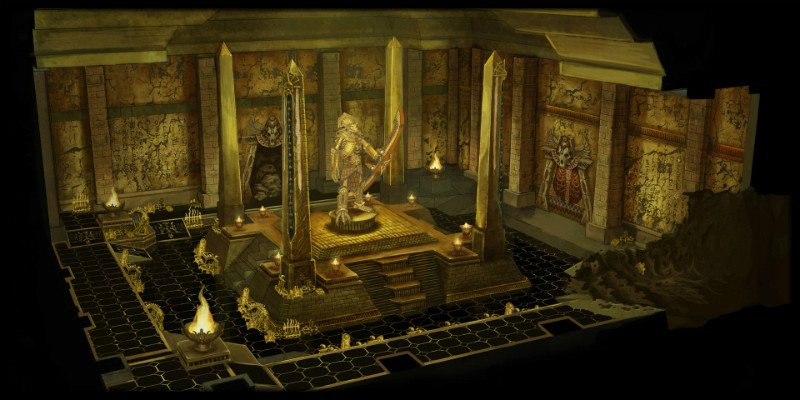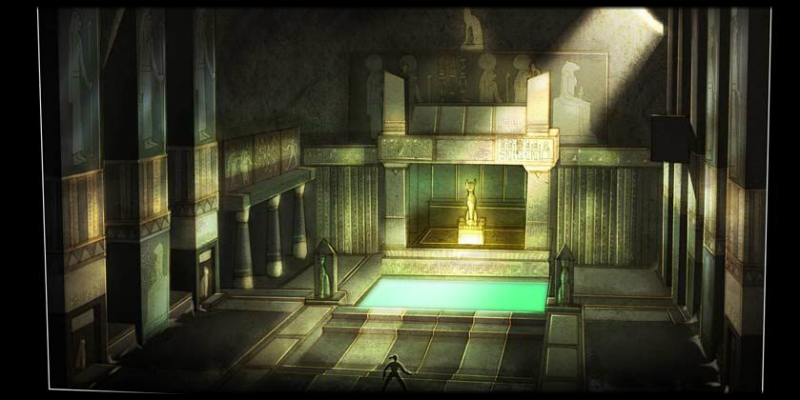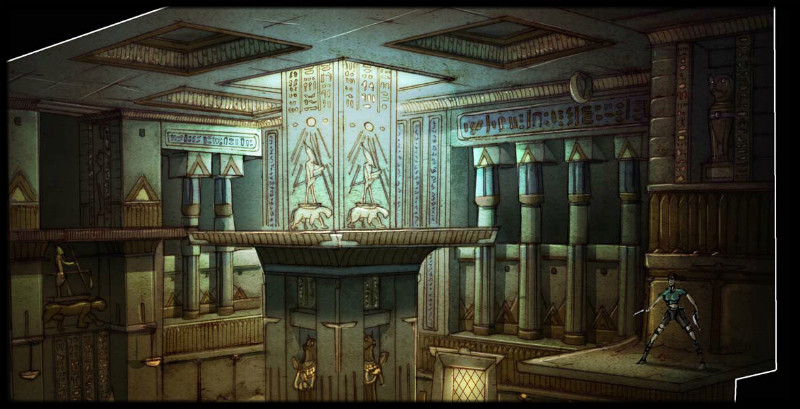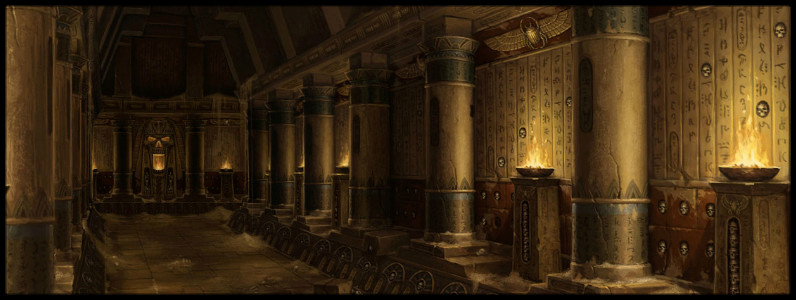
2 Re: Journey along the Nile Mon Nov 26, 2018 8:08 am
Re: Journey along the Nile Mon Nov 26, 2018 8:08 am
Aisha Kurosawa
D-rank
THE JOURNEY
Rising from the Grave
Sunagakure is destroyed. Not even its ruins were allowed to remain as the elemental Nations moved towards the desert to leave their mark upon what little remained of the once Great Nation of Wind. The Siege of Inabayama made the earth tremble under the drum of footsteps belonging to countless warriors driven forward by powers unseen. The sand embraced their life and fame as they fell before opposition, the wind carrying on their legacy and glory upon faint whispers. A land in chaos, their bodies now litter the sand. Left to be forgotten under the blistering sun.
When the Nations returned home with pride, old pharaohs stirred in their eternal dreams with wrath. Those left to the vultures would find a new home within the a hidden temple of the desert, their memories enlisted into the army of once noble lord and ladies. Where the dead are prepared to be given new purpose, life surfaces to find the golden lands in need of nourishment and guidance.
3 Re: Journey along the Nile Mon Nov 26, 2018 8:49 am
Re: Journey along the Nile Mon Nov 26, 2018 8:49 am
Aisha Kurosawa
D-rank
THE SOURCE
The Cult of the Tomb Kings
The Cult of the Tomb Kings is a sect mostly keeping to themselves as they live in a distant underground temple hidden by old incantations commanding the Fata Morgana and wind devils of the desert themselves. Guided by the god Sutekh, the Desert Lord, who embodies the chaos of the desert, the shifting sands unbound by rules and the lack of life it brings forward, the cult reveres its many aspects as a path towards legitimate strengths.
The snake and jackal being associated with the Cult as their kindred spirits, people who are known members of the Cult are mostly considered sly and unreliable, favouring only their own rather than the masses. Like snakes, their true intentions are shrouded, their words poisoning the mind, their actions ultimately destroying the greater good for their selfish desires. And like the jackal, these Cult followers can only bring forward harmful deceptions, devouring others for their own sustenance.
What many fail to understand is that though the Cult is considered as heralds of chaos, bringing change and ruin, they are not the sort to delve into madness and thoughtless violence. The Cult harnesses Chaos as a concept to maintain balance with the concept of Order, mostly making them unpredictable, creative and rebellious or difficult to work with. Much like their true intentions remain hidden, so too will many find that their kindness, warmth and honour is simply buried under layers of shifting morals. After all, one can only uncover the medicinal aspect of the Chaos Snake after having suffered its venom.
The medicinal aspect of the Cult flows forward from the alternate perspective that it is not Chaos which opposes Order, but Order which opposes Chaos. The land itself, before Man set foot, was wild and chaotic. Hunter and hunted were in balance despite the fluctuations. When Man arrived to bring Order, it wrought control from the lands and took it for its own gains. Natural balance was disturbed in favour of a pyramid-like structure that granted one person far more power than he should have - but the land has its way to balance such foolishness, these rulers often finding themselves the victim of assassinations. Or in the case of Sunagakure, at the hands of traitors and shinobi mad with power.
The Cult is carried by mortal minds, however, and empathy drives them towards an understanding that Man and land seek their own ways to cooperate with each other. The many dead littering the desert are all being given a proper burial regardless of origin, their hearts to be weighed on the scales of another God serving as the patron of the Cult. Anubis, the Guardian Lord, is the aspect of the tomb guardian watching over the dead and their graves. His teachings guide the Cult towards a veneration and preservation of the dead. When a dead enters the Temple of the Tomb Kings, it is cleansed, embalmed and wrapped in bandages before given a final resting place in the catacombs.
Much like the Cult's general inclination towards hidden intent and chaos is attributed to the snake, so too are the bandages the symbol of the snake's constriction over the dead - the tight embrace of the snake, holding on a valued treasure to be guarded against all those who would see it taken away. As the dead do not suffer poisons nor pain, they remain unharmed by the serpent guardian and find her instead to be a fierce protector rather than a killer.
This part of the snake is further strengthened by their worship for Kebechet, the Snake Lady, whose name means 'cooling water'. She is matron of the cleansing waters and the liquid oils and balms that are used to preserve the dead. She is the one said to have taught the mummification technique to the Cult, and teaches how to bring them back to life in times of need - True Resurrection or Human Puppetry, the means matter not if the result is achieved.
The Temple of the Tomb Kings
Chamber of AnubisShould one find the entrance to the hidden temple, this is the first room they'll be entering. The desert sand is spread across the earthen stones that shape this 10 by 10 meters room. The walls are chipped by age here and there and decorated with a variety of pictures and symbols from which the meaning has long since been lost to the cult itself.
The gaze of the solemn guardian in the middle of the room, standing on a 1 by 1 socket, carried by a raised platform that sizes 3 by 3, falls without fail upon all those who enter the temple. The stone statue of the Tomb King Anubis, the guardian, is an imposing form that gives a quiet warning to invaders not to continue their desecration. While this silent threat is easily shrugged off, the secret of the statue, known by few members of the temple, is that its unveils stealth techniques as people enter and activates a warning system placed through the temple when it does so.
This chamber leads into the harsh desert and into the Chamber of Kebechet through ornate doors.
Chamber of KebechetCompared to the oppressive Chamber of Anubis, the Chamber of Kebechet is a treasured sanctuary. This 10 by 7 meters room serves to cleanse hands and feet of visitors and cultists alike, a ritual maintained since generations in honour of Kebechet, who's known as the Tomb King who granted the secrets of oils and balms.
In the beautifully crafted 4 meters wide alcove on the other end of the entrance stands the proud sandstone statue of Kebechet, the six-armed half-woman half-serpent aspect ruling over cleansing and healing traditions. Right in front of her the cleansing baths dissuades intruders from reaching for her sacred alcove, the 4 by 2 meter wide pool a treasured price in the harsh sands of Sunagakure. These baths, considered as consecrated waters, are filtered and cleansed in turn by hidden mechanics to maintain its purity as it is regularly used for ritualistic cleansing.
This room leads to the Chamber of Anubis and to the Chamber of Sutekh.
Chamber of SutekhThe Chamber of Sutekh is both a marvel to behold and a dreaded place to be. The sandstone bricks used to build this room have created a 5 by 7 meters room which has been decorated with a variety of dyed artwork. A small border just wide enough to fit one person partially disappears behind the sturdy pillars until it reaches the hidden door in the walls on the other side of the room.
From the roof and under the raised path in the room are several entrances that allow all sorts of snakes to slither in and out of the pit that surrounds the main support pillar in the middle of the room. These snakes do not hesitate to lash out at anyone foolish enough to step inside their realm. A well guarded secret about the snakes is that they are placated by, or at least less hostile towards those who were respectful enough to undergo the ritualistic cleansing in the consecrated pool within Chamber of Kebechet. Why this is the case remains an enigma even within the cult, stories having it that the Tomb Kings themselves despise those without the slightest sense for humbleness and purity.
This room leads to the Chamber of Kebechet and into the Corridors of the Underworld
Corridors of the UnderworldThe Corridors are another line of defence should the temple ever be invaded. A veritable maze, all hallways look identical to each other. Sandstone walls, thick pillars supporting the ceiling, decorations of scarabs and ancient scrips long forgotten. Bowls filled with eternally burning oil provide dim light as one navigates the maze to find their room of choice.
With the exception of the Sanctum that will be described in the next section, the Corridor leads into various rooms both common and personal. Dormitories, personal bedrooms, bathrooms, kitchen and dining rooms. All of them are available if one knows where to find them. These rooms are small in size, generally not meant to be crowded by more than a handful of members at a time.
The maze leads to the Camber of Sutekh, the Sanctum and a variety of rooms serving different purposes.
Prominent Members
Kurosawa, Aisha - That's me!
Kurosawa, Fahima - My mother, leading Priestess of the Cult's Temple.
Nagini - Serpent Guardian of the Temple
Last edited by Aisha Kurosawa on Thu Nov 29, 2018 10:17 am; edited 5 times in total
4 Re: Journey along the Nile Mon Nov 26, 2018 8:59 am
Re: Journey along the Nile Mon Nov 26, 2018 8:59 am
Aisha Kurosawa
D-rank
THE RIVER'S FLOW
Encounters
"No life exists without it touching another.".
A simple sentence with many meanings. As Aisha's journey moves on she is bound to meet a variety of people. How she will influence them or how they will influence her remains to be seen.
Makoto Nova - Kazekage?
Karisuma Izumi - paramour to Nova
Kodai Myrddin - member of the prestigious Kodai family.
Last edited by Aisha Kurosawa on Sat Jun 15, 2019 5:45 am; edited 1 time in total
5 Re: Journey along the Nile Mon Nov 26, 2018 9:06 am
Re: Journey along the Nile Mon Nov 26, 2018 9:06 am
Aisha Kurosawa
D-rank
THE VISIONS
Genin
One can never predict how the river will flow as it searches to reach the sea. All one can say is that it came from somewhere and that it will end up somewhere. The same applies to Aisha, who at this point is merely seeking life's flow hidden in the desert sand.
Stats: E-0
Jutsu: -
Missions: -
Threads: -
Similar topics
Permissions in this forum:
You cannot reply to topics in this forum
Log in
Wordcounter
The Five Kage
 Hokage: Kimura, Takao
Hokage: Kimura, Takao Kazekage: Makato, Nova
Kazekage: Makato, Nova Raikage: Vacant
Raikage: Vacant Tsuchikage: Maikumaru
Tsuchikage: Maikumaru Mizukage: Miki, Fuyuko
Mizukage: Miki, FuyukoLatest topics
» Memory Lane
by Daisuke Wed Oct 12, 2022 12:46 am
» Remember we are Saga
by Hanabi Sun Nov 22, 2020 3:40 pm
» A sundae
by Kisei Sun Dec 29, 2019 1:19 am
» Call me by your sanded name [Takao / Invite only]
by Kisei Wed Dec 18, 2019 1:35 pm
» Admin Requests
by Hanabi Tue Dec 17, 2019 12:13 pm
» Academy Lessons [Kinko]
by Hanabi Tue Dec 17, 2019 12:10 pm
by Daisuke Wed Oct 12, 2022 12:46 am
» Remember we are Saga
by Hanabi Sun Nov 22, 2020 3:40 pm
» A sundae
by Kisei Sun Dec 29, 2019 1:19 am
» Call me by your sanded name [Takao / Invite only]
by Kisei Wed Dec 18, 2019 1:35 pm
» Admin Requests
by Hanabi Tue Dec 17, 2019 12:13 pm
» Academy Lessons [Kinko]
by Hanabi Tue Dec 17, 2019 12:10 pm
Read Naruto Manga
- Free forum | © PunBB | | Report an abuse | Cookies
 Home
Home



















